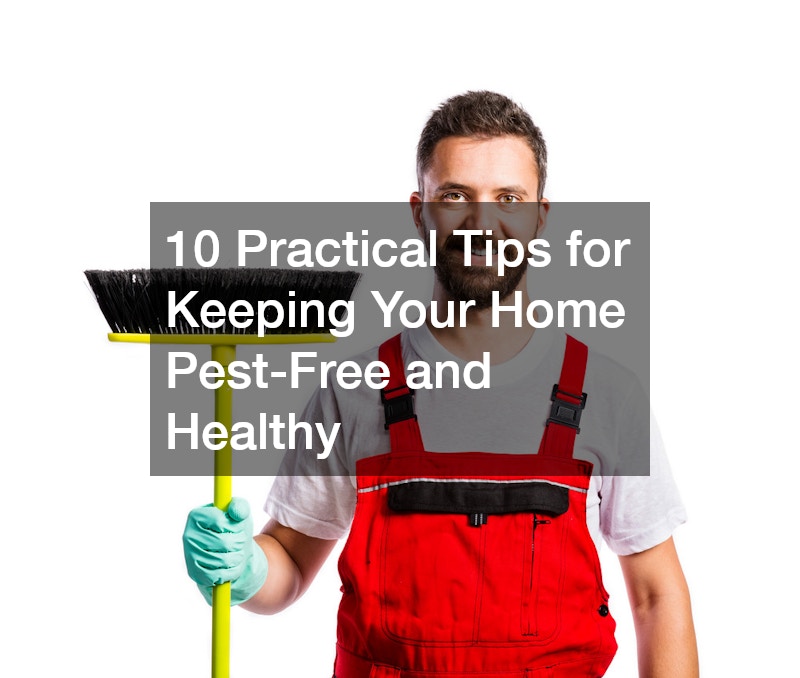Keeping your home pest-free is not just about maintaining cleanliness—it’s essential for protecting your family’s health and well-being. Pests can carry diseases, contaminate food, and cause significant damage to your property if left unchecked. From tiny ants to rodents, these unwanted guests can quickly turn your safe haven into a stressful environment.
Creating a healthy, pest-free home doesn’t require drastic changes, but it does call for consistent maintenance and preventative measures. By addressing vulnerabilities and implementing smart strategies, you can minimize the risk of infestations while ensuring your living space remains safe and comfortable.
In this article, we’ll explore 10 practical tips to help you keep your home free of pests. These steps, ranging from routine cleaning to professional maintenance, are designed to protect your home and create a healthier environment for your family. Let’s dive into the actionable solutions that can make a real difference.
1. Fix Leaks and Ensure Proper Drainage

Standing water and moisture are magnets for pests like mosquitoes, cockroaches, and rodents. Even small leaks or drips can create the perfect environment for pests to thrive. To prevent this, it’s essential to inspect your home regularly for plumbing issues and address them promptly.
A plumbing contractor can help you identify and repair leaks in faucets, pipes, and water fixtures. They can also ensure proper drainage to eliminate water pooling around your home, which can attract pests. Check under sinks, behind appliances, and in basements or crawl spaces where leaks are more likely to occur.
Additionally, keep an eye on your outdoor spaces. Ensure gutters and downspouts are clear and direct water away from your foundation to avoid standing water. By maintaining a dry and well-drained home, you significantly reduce the risk of pest infestations while also protecting your property from water damage.
2. Keep Your Kitchen Organized and Tidy
Your kitchen is a common target for pests like ants, cockroaches, and rodents because it provides easy access to food and water. To prevent infestations, maintaining a clean and organized kitchen is crucial.
Start by regularly cleaning countertops, floors, and appliances to remove crumbs and spills. Pay special attention to your kitchen cabinet, where food items are often stored. Inspect cabinets for signs of pests, such as droppings or chewed packaging, and organize them with airtight containers to keep food safe and inaccessible.
Don’t forget to empty the trash frequently and keep the bin sealed. Also, clean under large appliances like stoves and refrigerators, where crumbs often accumulate.
A clean and clutter-free kitchen not only discourages pests but also makes it easier to spot any early signs of an infestation. Consistent habits and attention to detail are your best defenses in keeping pests at bay.
3. Repair Damaged Screens and Seal Openings

Small openings in your home can serve as entry points for pests like flies, mosquitoes, and even rodents. Damaged window or door screens are one of the most common vulnerabilities. To keep pests out, it’s essential to inspect and repair these openings regularly.
Hiring a professional for screen repair ensures that any tears or holes in your window and door screens are properly fixed. Additionally, check for gaps around doors, windows, and vents. Use weather stripping or caulk to seal any cracks and prevent pests from finding their way inside.
Pay close attention to less obvious areas, such as attic vents, chimneys, and utility entry points, as these can also serve as gateways for pests. By keeping your home well-sealed and maintaining strong screens, you create an effective barrier that minimizes pest intrusion while improving your home’s energy efficiency.
4. Clean Your Drains and Sewer System
Clogged drains and sewer lines can become breeding grounds for pests like cockroaches, drain flies, and rodents. The buildup of food residue, grease, and other debris in your plumbing can attract pests and create unhygienic conditions. Regular sewer and drain cleaning is essential to prevent these issues and maintain a healthy home.
Professional sewer and drain cleaning services can help clear blockages and ensure your system is functioning properly. Focus on areas like kitchen sinks, bathroom drains, and basement floor drains, as these are common spots for pest activity.
In addition to professional cleaning, use natural drain cleaners or boiling water regularly to prevent clogs and eliminate food particles. Don’t forget to inspect outdoor drains and gutters, as they can also contribute to pest problems. Maintaining clean and clear drains reduces the risk of infestations and ensures a healthier living environment.

